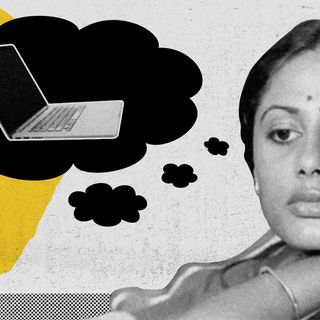
All You Need To Know About Maladaptive Daydreaming
Maladaptive daydreaming is a form of dissociation, often as a coping mechanism from trauma, abuse or loneliness.

Most people daydream, maybe even everyday. But, certain individuals possess the ability to daydream so vividly that they can experience their presence in the imaginary environment of their creation. While experiences of such vivid, active day-dreaming may seem odd to some, they’re extremely commonplace for a lot of people — and, in some cases, depending on a number of factors like severity and frequency, may suggest a psychiatric condition called maladaptive daydreaming, or MD. In addition, these individuals also experience constant compulsions to switch to the fantasy several times during the day, which has led experts to believe that it is a behavioral addiction. However, this is still an evolving area of research, and is yet to be formally recognized as a disorder by the American Psychiatric Association (APA).
Those who suffer from this condition reportedly spend almost 60 percent of their waking hours in imaginary worlds of their own creation — but, without losing touch with with the real world, and realizing that it is a fantasy they are immersing themselves into.
What is maladaptive daydreaming?
MD is a form of dissociating oneself from the real world, and getting absorbed into fantasies and mental imagery comprising vivid alternative universes, usually involving elaborate scenarios — that the individual prefers over reality.
People suffering from this condition consider it a disorder because it often interferes with the individuals’ social, academic or professional life, especially so, if they begin to replace human interactions with fantasy. In fact, a 2016 report by CNN on the subject described a Californian maladaptive daydreamer, who kept getting fired from jobs because she was often distracted, nervous or late to work on account of being caught up in fantasies.
This condition was first identified and christened by Eli Somer, Israeli Professor of Clinical Psychology at the University of Haifa, during his study on dissociative behaviors in 2002. Then, in 2011, psychologist Cynthia Schupak, and Jayne Bigelsen, a Harvard-educated lawyer and anti-trafficking activist, who also studies trans-cultural psychiatry and is a maladaptive daydreamer, co-authored a peer-reviewed study of 90 self-identifying maladaptive daydreamers who fantasize excessively in course of their everyday lives.
Their research found a set of remarkably specific behaviors in study-subjects who engaged in extensive periods of highly-structured, immersive imaginative experiences, with 79 percent of them reporting kinesthetic engagement with their fantasies. They also reported difficulties in overcoming the compulsion to daydream and concerns that their fantasies are interfering with their real-life relationships and endeavors. Currently, several scientific studies are ongoing in the US, Poland and Switzerland, among other countries, to understand the phenomenon better.
“It was as if I’d lost the remote control and the TV set in my head was running constantly, never turning off,” Bigelsen told The Atlantic in 2015.
“My earliest memories are daydreams. I recall being a toddler lying around fantasizing about climbing a rainbow into a land of princesses. Now I’m 36, and I’ve retreated to the same daydream world I constructed when I was 9. At first, this world was a fictional city in California with no name, but when I turned 20, I moved to France for a few years, so all my characters did too. These days, my world is set in a country that I rule as queen,” a 36-year-old from Portland, Oregon, who described himself as a maladaptive daydreamer, told The Cut in 2016.
Related on The Swaddle:
All You Need To Know About Avoidant Personality Disorder
What are the symptoms of maladaptive daydreaming?
The fifth Diagnostic and Statistical Manual, or DSM-5, does not recognize MD. So, in the absence of DSM-5 criteria for its diagnosis, there is Somer’s Maladaptive Daydreaming Scale (MDS) to help determine whether an individual is experiencing MD — MDS is a 14-point scale that rates five primary characteristics of the condition:
- Content and quality (detail) of dreams;
- Individual’s ability to control their dreams and/or the compulsion to dream;
- Amount of distress caused by daydreaming;
- Individual’s perceived benefits of daydreaming;
- Extent of interference of daydreaming with the individual’s ability to carry out their daily activities.
In addition to these, people may also be asked to rate how often they experience MD.
Interestingly, researchers on the subject have noted that people suffering from MD also report higher rates of attention-deficit and obsessive-compulsive symptoms along with a history of depression and/or anxiety disorders — although experts are still not sure why.
What causes maladaptive daydreaming?
Experts believe that MD is, generally, a coping mechanism in response to trauma, abuse or loneliness that leads the maladaptive daydreamer to conjure a complex imaginary world for them to escape into in times of distress, or loneliness, or maybe, even helplessness in real life. It is an escapist method of avoiding real interactions with families, friends or colleagues.
In his study, Somer had identified six survivors of sexual assault, who would escape regularly into an imaginary world of their creation, where they fantasized about their existence in compensatory, empowering storylines that they found missing in their real lives. “One man told us about 35 characters participating in the repertoire of stories he imagines. Another related how, for 30 years, he has been repeatedly imagining the plots of a series that is constantly evolving. Daydreaming usually starts as a small fantasy that makes people feel good, but over time, the process becomes addictive — until it takes over their lives. But because until now, the disorder has been unknown, when they come to receive treatment, therapists usually dismissed their complaint,” Somer said. However, Bigelsen believes that there the causes extend way beyond Somer’s trauma theory.
Can maladaptive daydreaming be treated?
Owing to the absence of a medical recognition of the condition, MD is often treated as a neural biochemical imbalance rather than an addictive symptom stemming from trauma, or a void in the individual’s life, if at all medical practitioners accord it enough importance.
Experts believe that cognitive behavioural therapy, or talk-therapy that helps people manage their day-to-day problems by changing the way they think and behave, can address their compulsive need to slip into their imagination. In terms of medication, one study had found that fluvoxamine, a drug commonly used to treat OCD, can help control MD as well. Over the years, a number of online communities of self-diagnosed maladaptive daydreamers have also emerged to help each other out.
When the medical community formally recognizes the disorder, perhaps, there will be more streamlined and nuanced approaches to treating those held hostage by their daydreams — in fact, in 2014, a Texas student named Cyan Reed had even launched a petition on Change.org urging the APA to acknowledge MD as a disorder.
“Maladaptive daydreaming still isn’t an officially recognized condition, but it’s clear that people around the world are experiencing the same symptoms: the hypnotic movements, the plots and characters, and the crippling inability to focus on the real world. As a researcher, I hope to find out much more about this condition and help the medical profession learn to address it,” Bigelsen said.
Devrupa Rakshit is an Associate Editor at The Swaddle. She is a lawyer by education, a poet by accident, a painter by shaukh, and autistic by birth. You can find her on Instagram @devruparakshit.
Related


Why Do We Cringe?
